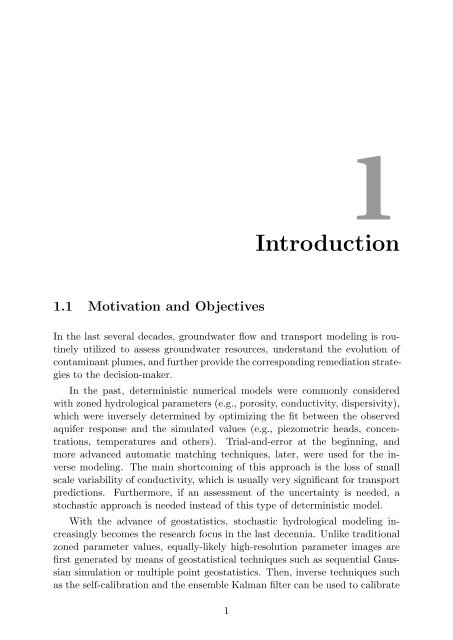Upscaling and Inverse Modeling of Groundwater Flow and Mass ...
Upscaling and Inverse Modeling of Groundwater Flow and Mass ...
Upscaling and Inverse Modeling of Groundwater Flow and Mass ...
You also want an ePaper? Increase the reach of your titles
YUMPU automatically turns print PDFs into web optimized ePapers that Google loves.
1.1 Motivation <strong>and</strong> Objectives<br />
1<br />
Introduction<br />
In the last several decades, groundwater flow <strong>and</strong> transport modeling is routinely<br />
utilized to assess groundwater resources, underst<strong>and</strong> the evolution <strong>of</strong><br />
contaminant plumes, <strong>and</strong> further provide the corresponding remediation strategies<br />
to the decision-maker.<br />
In the past, deterministic numerical models were commonly considered<br />
with zoned hydrological parameters (e.g., porosity, conductivity, dispersivity),<br />
which were inversely determined by optimizing the fit between the observed<br />
aquifer response <strong>and</strong> the simulated values (e.g., piezometric heads, concentrations,<br />
temperatures <strong>and</strong> others). Trial-<strong>and</strong>-error at the beginning, <strong>and</strong><br />
more advanced automatic matching techniques, later, were used for the inverse<br />
modeling. The main shortcoming <strong>of</strong> this approach is the loss <strong>of</strong> small<br />
scale variability <strong>of</strong> conductivity, which is usually very significant for transport<br />
predictions. Furthermore, if an assessment <strong>of</strong> the uncertainty is needed, a<br />
stochastic approach is needed instead <strong>of</strong> this type <strong>of</strong> deterministic model.<br />
With the advance <strong>of</strong> geostatistics, stochastic hydrological modeling increasingly<br />
becomes the research focus in the last decennia. Unlike traditional<br />
zoned parameter values, equally-likely high-resolution parameter images are<br />
first generated by means <strong>of</strong> geostatistical techniques such as sequential Gaussian<br />
simulation or multiple point geostatistics. Then, inverse techniques such<br />
as the self-calibration <strong>and</strong> the ensemble Kalman filter can be used to calibrate<br />
1


